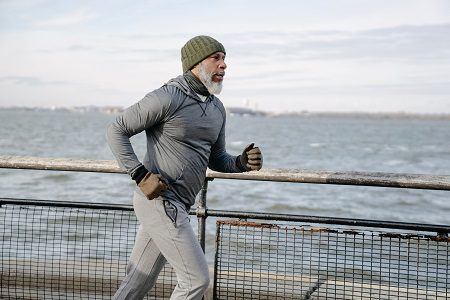Our bodies need a well-rounded approach. Experts say there are four types of exercise that are best for us overall, especially after 55.
Strength Training + Cardio + Stretching + Balance
Strength training
Strength training (also known as resistance exercise) builds muscles by making them work against a weight or force.
Examples: working with resistance bands, heavy gardening (such as digging and shoveling), climbing stairs (this counts as cardio too), hill walking, cycling, lifting weights, push-ups, sit-ups, squats, and, yes, dance moves build muscle too.
How often? The CDC recommends muscle building activities a minimum of two days per week.
Cardio
This is what comes to mind when most of us think about staying fit. Cardiovascular exercise is any vigorous activity that increases heart rate and respiration and raises oxygen and blood flow throughout the body.
Examples: Brisk walking, running, swimming, cycling, playing tennis, jumping rope, hiking, stair climbing, and many types of dancing.
How often? The American Heart Association recommends a minimum of 150-minutes of moderate exercise or 75-minutes of vigorous exercise per week. More than this is even better. Start slow and talk to your doctor before you start if you have a preexisting condition.
Stretching
According to Harvard Medical School, all healthy adults should do flexibility exercises. Stretching is a must for older adults to stay limber and keep their range of motion.
Examples: yoga, tai chi, or simple stretches that hit all major muscle-tendon groups—neck, shoulders, chest, trunk, lower back, hips, legs, and ankle.
How often? At least 2-3 times per week or whenever you get the chance. For optimal results, spend 60 seconds on each exercise.
Balance exercises
Falls are the second leading cause of unintentional injury deaths worldwide so keeping our balance is especially important as we grow older. Simple balance exercises can help us stay lighter on our feet and avoid falls.
Try a 10-second balance test. In this test, done in less than a minute, stand one-legged on either leg for ten seconds. According to research, better balance is linked to greater longevity so practicing our balance after 55 is very important. Here’s an interesting article that talks about the significance of the 10-second balance test.
More examples: Try walking in a line, heel-to-toe, for a short distance. If you need visuals, check out this this Mayo Clinic slide show.
How often? As often as possible.
If you’re reading this and you spend a lot of time sitting, it’s not too late. Moving your body is an easy way to prevent or delay health problems that seem to come with age. Exercise can reduce pain, relieve stress, improve sleep, enhance flexibility and balance, lower risk for chronic disease and injuries, and increase “good” cholesterol, among many other benefits.
What small step could you take in the next week to incorporate a new kind of movement into your day?
Let me know if I can help you continue your personal conversation around wellness.
—————————-
Resource Links:
How can strength training build healthier bodies as we age? National Institute on Aging
How a 10-Second Balance Test May Help Older Adults Predict Longevity Health Newsletter
Fall prevention exercises. Johns Hopkins Medicine
The ideal stretching routine. Harvard Health
How much physical activity do older adults need? Centers for Disease Control and Prevention
Fitness tips for 50+, Johns Hopkins Medicine
Exercise Intensity: How To Measure It. Mayo Clinic
Target Heart Rate. American Heart Association

